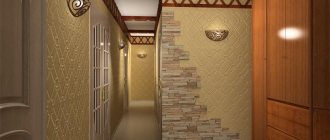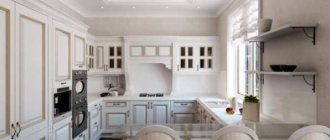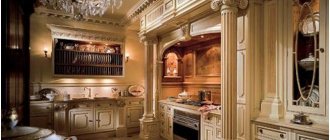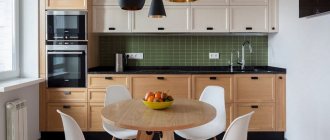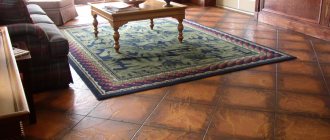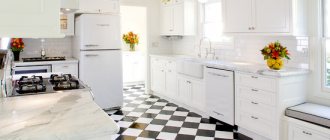Decorative stone in the kitchen
Black, pinkish or gray stone, with a cool glossy or matte surface, gives the room a touch of noble elegance.
When developing a design, such types of finishes should be chosen that can easily maintain cleanliness without violating environmental and sanitary hygiene requirements. One of the most popular finishing materials for walls is decorative stone. Although decorative plaster can imitate stone.
Artificial stone is the general name for construction and repair products that combine types of wall and floor cladding of different quality and design.
Kinds
Finishing stone is a product of processing natural raw materials (clay, feldspar, quartz, stone chips) with the addition of modifying additives and pigments. The main types of material that are most widespread in modern finishing work are:
- porcelain stoneware (made under pressure from clay and feldspar);
- agglomerates (the basis of the composition is stone chips, polyester resins, various additives);
- stone and brick made of colored concrete (a material created on the basis of Portland cement and sand).
Each group of materials has its own purpose in interior decoration. Thus, porcelain stoneware, imitating the surface of rock granite, and characterized by monumental aesthetics, is most often used for cladding floors, window sills, and walls of the work area.
Stone is used to decorate not only the walls, but also the countertops or underframes.
Agglomerates (acrylic stone), characterized by absolute similarity to natural minerals, are an ideal finish for functional areas and furniture surfaces. Thanks to the content of colored pymentos, the natural pattern of minerals (jasper, malachite, agate, marble) becomes more expressive and bright.
Here is an interesting option for finishing with colored concrete.
Colored concrete is a renovation material that has become very popular among decorative artists due to its beautiful texture and universal quality properties (the material looks beautiful in the interior space and is easy to lay on flat and radial surfaces). The design work uses decorative brick, textured stone with imitation of manual surface treatment, and facing tiles similar in appearance to shell rock.
Beautiful finish - stone combined with a painted wall
All types of artificial stone are environmentally friendly finishes (they do not absorb dust, do not accumulate static electricity, and do not interfere with normal air exchange). However, when choosing a finishing material, you need to be aware of its disadvantages. There are very few of them.
A group of decorative materials, with proper care, retains the design aesthetics for decades, which is what has determined such a high demand for this type of cladding.
Acrylic stone is vulnerable to abrasive, caustic chemicals and high temperatures. Ceramic tile is susceptible to strong mechanical stress. Concrete-based stone cannot be used in rooms with high humidity.
How to make brickwork in a panel house, video:
Design styles for countertops, splashbacks, walls, ceilings
Designers offer many options for decorating walls and ceilings, taking into account the area of the space, layout, level of natural light, and taste preferences of the property owner. Both one style and a combination of several styles are used. Let's look at the most popular style solutions.
Chalet
A chalet-style kitchen will turn your apartment into a hunting lodge
Chalet is a shepherd's hut. This style was borrowed from French architects, who took as a basis the houses of shepherds living in the highlands. This design option is only applicable for spacious rooms with high ceilings and beams on the ceiling.
Colored concrete is used as wall cladding. The surface should be textured, with an imitation of artisan finishing - that is, the stone fragments protrude slightly and do not form clear boundaries.
The working wall (apron), arch (replacing the door), windows, and part of the dining area are covered. Stone goes well with wood and metal, living green plants.
Country
A country style kitchen is a successful symbiosis of stone and wood.
Country is the general name for styles where rustic motifs are dominant. Each country has its own customs and peculiarities of kitchen design. Depending on the chosen line of artistic decoration, certain accessories and household items are used. The country style interior looks like home.
A stone with a rough convex texture (shades of beige, gray, black, terracotta) or decorative brick with a rough surface is selected for cladding.
Country kitchen projects with and without stone trim in our selection:
Cladding areas - entrance door, stove (fireplace) area, windows, work wall. The flavor of the rural setting is enhanced by household utensils and solid wooden furniture.
English zone
Design in the English style is an example of nobility and elegance. In English interiors, expensive finishing materials were used, which in their combinations created a harmonious picture of a cozy environment.
Victorian style is a mixture of English elegance and rustic rusticity.
White and pink marble, malachite, mother-of-pearl - these minerals were used in past centuries by London artisans to decorate aristocratic interiors. With the advent of decorative stone, designers have the opportunity to recreate interior compositions that are distinguished by sophisticated elegance. Kerama Marazzi – British collection of tiles in fusion style, read here.
Acrylic stone is used for cladding countertops and work aprons; porcelain tiles in large slabs are laid on the floor. All colors are strictly kept within the pastel range - pink, beige, coffee, milky.
Romanesque renovation
Romanesque style is an option for transforming a kitchen into a medieval castle
The Romanesque (Roman) style of kitchen design is not suitable for lovers of a nice home environment. This interesting idea is characterized by monumental forms, emphatically simple surface finishing, a large number of mosaic patterns and carved images (these can be warriors, zodiac signs, images of animals, geometric figures).
There is a lot of stone in the interior - the floor, walls, doorways, columns and steps.
A kitchen designed in the Romanesque style is certainly a suitable option for a large country house with castle architecture. For finishing the walls and floors, gray and beige cement stone is chosen, imitating untreated granite or marble.
Modern decor styles
Modern styles also actively use decorative stone
In recent years, styles subordinated to the principles of convenience and practicality have dominated. Furniture and household appliances create a single compositional line, the middle of the room is free, and there are blinds or roller blinds on the windows. A lot of air, light, a minimum of unnecessary details. This is what a kitchen designed in the style of “minimalism”, “high-tech” looks like, the design of a living room kitchen in a loft style. A combination of different style solutions is also used, while observing the principles of design planning.
More often used in decorative styles, for example, this wall
To decorate the modern minimalist interior space of the kitchen and dining room, artificial stone with a smooth glossy surface is used. Both contrasting combinations (red-gray, blue-white, orange-light green) and soft colors are popular in compositional solutions. Large porcelain stoneware tiles are laid on the floor, and furniture facades, countertops, and bar counters are lined with plates of acrylic stone, which can be plain or imitating natural material.
What is loft style and its features:
Artificial (acrylic) stone, used for cladding countertops and sinks, is an extremely practical material - thanks to its elasticity and flexibility in processing, it is possible to create smooth transition lines between different functional areas and objects, which eliminates the accumulation of dirt in hard-to-reach places.
Antique interior
The classical style took a lot from Antiquity, and so did the use of stone.
Antique (ancient Greek) style is one of the fundamental classical styles, which are based on the principle of maintaining geometric proportions. When designing a kitchen, light stone is used to imitate the surface of marble. The tiles on the floor are large, with a rough surface. The walls are also finished with tiled light stone.
Very often, all surfaces in a room are covered with the same material in texture and color.
Characteristic elements of antiquity are columns, pilasters, porticoes, and sculptural bas-relief. Large spaces with arched windows and bay windows are suitable for decorating a kitchen in an antique style.
Modern design
This style is characterized by smooth shapes, smoothed corners, horizontal orientation of the arrangement of objects, and asymmetry in the placement of interior elements.
Modern Art Nouveau is devoid of the touch of luxury and pretentiousness inherent in the interiors of the 19th century, but introduces a touch of cheerfulness and elegant comfort into the atmosphere.
For cladding walls and floors, a smooth, monochromatic stone is used (usually black or white, ceramic tile).
Acrylic stone is used for finishing niches and openings, which are characteristic components of this popular and very effective design trend.
Kitchen aprons made of stone
It is in this part of the kitchen that stone can become an ideal coating. There are two reasons for this. The first is a completely unfavorable zone. This part of the kitchen has high levels of humidity, large temperature changes due to the stove, and a greater likelihood of damage and grease stains. Using stone to finish the apron, you can preserve its original appearance, despite mechanical stress.
The second is a unique design, where the central part will be the apron. As for the question - “Will a stone apron fit into the interior design of the kitchen?” – then it should be noted that if the kitchen is made in country, Provence, rustic or Mediterranean style, then using stone in the interior of the kitchen will be the right decision in all respects.
Minimalism and decorative stone
Do-it-yourself artificial stone laying
Home craftsmen who have no experience in laying decorative stone can gain first experience when tiling a small area of the room - for example, the space around the hood, or the area of the work apron, but also for zoning the kitchen and dining room.
It is recommended to choose a textured cement material, the work with which does not require high qualifications, unlike, for example, the installation of porcelain tiles.
- To lay the stone you will need: a spatula, primer, grout, glue, roller, pencil, corner, ruler, twine;
- after all calculation operations and measurements, the main work begins;
- a primer is applied to the wall using a roller, then the surface is leveled with a wide spatula;
- after the composition has dried, the base is coated with a thin layer of special glue (all building mixtures must be chosen correctly!);
- laying begins from the bottom edge - this is necessary so that the following blocks do not budge or slide down;
- the finishing element is applied to the surface and pressed lightly;
- to ensure even gaps between stones, plastic delimiters should be used - they are sold in hardware stores;
- Installation must be carried out quickly so that the glue does not have time to dry.
The technological process will not be complicated if you prepare everything necessary in advance and follow the technologies specified by the manufacturer.
Laying decorative stone, video instructions:
Caring for such a wall, interior decoration
Decorative stone is a material that is resistant to moisture, temperature changes in the room, and UV rays. Care is simple and does not require physical effort. It is not recommended to use abrasives and caustic chemicals. Read how to choose the right color combination here.
It is enough to wipe the surface with a damp cloth once every three days, more thoroughly treating the joints and relief recesses (if it is a textured material).
Decorative stone is one of the most popular materials among designers for interior decor, since it comes in a variety of finishes in texture, color and shape, which allows for the implementation of unique compositional solutions; this cannot be done with wallpaper. Additional advantages include strength, operational reliability, durability, and impeccable aesthetics. Decorative stone meets strict environmental and sanitary hygiene requirements and is relatively inexpensive, which, along with other advantages, has determined the growing demand for finishing materials.
Decorative stone in the kitchen interior - photo
If you can read about the technical characteristics of decorative stone, then you need to see the aesthetic properties with your own eyes. In this selection of photographs, we tried to illustrate the variety of textures, colors and solutions that will be the perfect complement to your kitchen design. Enjoy watching!
